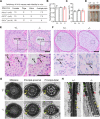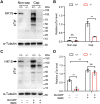Spermatogenic cell-specific type 1 hexokinase (HK1S) is essential for capacitation-associated increase in tyrosine phosphorylation and male fertility in mice
- PMID: 39074078
- PMCID: PMC11285943
- DOI: 10.1371/journal.pgen.1011357
Spermatogenic cell-specific type 1 hexokinase (HK1S) is essential for capacitation-associated increase in tyrosine phosphorylation and male fertility in mice
Abstract
Hexokinase (HK) catalyzes the first irreversible rate-limiting step in glycolysis that converts glucose to glucose-6-phosphate. HK1 is ubiquitously expressed in the brain, erythrocytes, and other tissues where glycolysis serves as the major source of ATP production. Spermatogenic cell-specific type 1 hexokinase (HK1S) is expressed in sperm but its physiological role in male mice is still unknown. In this study, we generate Hk1s knockout mice using the CRISPR/Cas9 system to study the gene function in vivo. Hk1s mRNA is exclusively expressed in testes starting from postnatal day 18 and continuing to adulthood. HK1S protein is specifically localized in the outer surface of the sperm fibrous sheath (FS). Depletion of Hk1s leads to infertility in male mice and reduces sperm glycolytic pathway activity, yet they have normal motile parameters and ATP levels. In addition, by using in vitro fertilization (IVF), Hk1s deficient sperms are unable to fertilize cumulus-intact or cumulus-free oocytes, but can normally fertilize zona pellucida-free oocytes. Moreover, Hk1s deficiency impairs sperm migration into the oviduct, reduces acrosome reaction, and prevents capacitation-associated increases in tyrosine phosphorylation, which are probable causes of infertility. Taken together, our results reveal that HK1S plays a critical role in sperm function and male fertility in mice.
Copyright: © 2024 Tian et al. This is an open access article distributed under the terms of the Creative Commons Attribution License, which permits unrestricted use, distribution, and reproduction in any medium, provided the original author and source are credited.
Conflict of interest statement
The authors have declared that no competing interests exist.
Figures







References
MeSH terms
Substances
LinkOut - more resources
Full Text Sources
Medical
Miscellaneous

